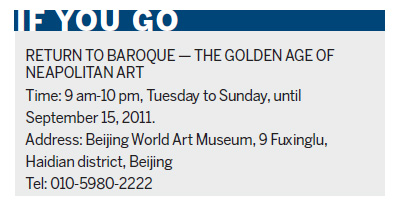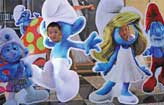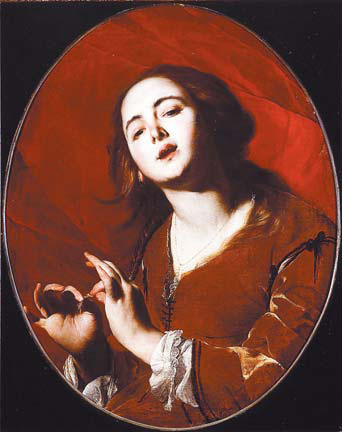Art
Humanity and desire focus of Baroque period art on show
Updated: 2011-08-17 07:54
By Zhang zixuan (China Daily)
|
The Soprano, oil on canvas, by Bernardo Cavallino. Provided to China Daily |
Fans of Baroque art, once derided as eccentric and a sad end to the glory of Renaissance art that preceded it, have a treat in store for them at the Beijing World Art Museum.
The exhibition, Return to Baroque - The Golden Age of Neapolitan Art, that runs until Sept 15, features 40 oil paintings from Italy's National Museum of Capodimonte in Naples, previously a Bourbon palace and now one of the best museums in Italy with a rich collection of paintings of the Neapolitan School, from the 13th to the 18th century.
Emerging around 1600 in Rome, Italy, and spreading to most of Europe till 1750, Baroque began with the innovations that artists Annibale Carracci (1560-1609) and Michelangelo Merisi da Caravaggio (1571-1610) brought to their paintings, and which were also reflected in sculpture, literature, dance, and music.
Breaking away from the harmonious, balanced, proportionate and symmetrical style of the Renaissance period - the heyday of Western arts - Baroque painting stresses conflict, dynamic, drama, great detail and intense light contrast. More importantly, it focuses on humanity and desire, and not the nobility and asceticism that Renaissance artists attempted to express.
The 40 exhibited paintings fall in two parts - The World of the Gods and The World of Humans - and attempt to present a comprehensive picture of Neapolitan art in the Baroque era.
The World of the Gods contains 25 artworks, of which six are based on Greek mythology and 19 are drawn from Biblical tales. "Although Baroque art portrays mythology as well, it intends to portray mythic figures as humans, not the myths themselves," explains Shao Dazhen, renowned Chinese art critic.
The painting Venus and Adonis by Giovanni Battista Caracciolo (1578-1635), Caravaggio's follower, expresses the god-man situation vividly.
The work captures the scene when Venus meets her lover Adonis in the forest. The goddess is shown with half of her breasts and right leg exposed. She has her right hand on Adonis' right arm, trying to stop him from leaving her.
"The image hints at a sequence of movements and continuous joy," says Ding Ning, professor of School of Arts, Peking University.
Another difference between Renaissance and Baroque art is in the way they present Biblical stories.
"The Renaissance tended to express all that was positive and noble in the Bible, while the Baroque artists chose to reveal how the saints suffered, which mirrored the reality back then," Shao says.
A good example is Saint Agatha painted by Francesco Guarino (1611-1654). In it, Agatha is shown covering her bleeding chest with a piece of white cloth - her breasts were cut off for refusing the love of Quintiniano, the Roman Consul in Sicily.
The second part of the exhibition, The World of Humans, on the other hand, includes four portraits, four paintings on historic events, five on customs and two on still objects. It shows how the Baroque artists were enthusiastic about, and loyal to, portraying reality even when it was ugly. And this was one of the reasons for Baroque art being criticized.
Yet Baroque artists have also captured the beauty of reality. In The Soprano by Bernardo Cavallino (1616-1656), a beautiful female singer is framed by a red cloth, her mouth open as if ready to sing.
The exhibition's next stop is the Hubei Provincial Museum in late September. It will then move to the Guangdong Provincial Museum from early December till February next year.


Specials

Star journalist leaves legacy
Li Xing, China Daily's assistant editor-in-chief and veteran columnist, died of a cerebral hemorrhage on Aug 7 in Washington DC, US.

Robots seen as employer-friendly
Robots are not new to industrial manufacturing. They have been in use since the 1960s.

Smurfs up in China
The movie remake of a classic 1980s cartoon series is expected to have special cross-generation appeal to Chinese filmgoers
